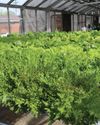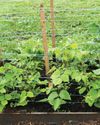Intentar ORO - Gratis
When it RAINS...
Hobby Farms
|July-August 2023
Today's weather can be bust or boom, and bioswales and rain gardens help control the overflow during boom times.

No matter where you live and garden, odds are you’ve noticed at least some changes in your local weather patterns over the last several years. Throughout much of the United States, for instance, we’ve seen new extremes — more intense rains punctuated by prolonged periods of drought.
A 2019 research brief released by the policy- neutral nonprofit group Climate Central notes that for every degree Fahrenheit rise in temperature, our atmosphere can hang onto about 4% more water vapor. That means as temperatures go up, the stage is set for even heavier deluges when it does rain. Climate Central researchers analyzed the rainiest days of the year for 244 U.S. cities and determined that, “Since 1950, the wettest day of the year has gotten wetter in 79% of the cities analyzed.
“In addition to getting stronger, extreme downpours are happening more frequently than in the past. In 80% of the cities analyzed, the top 1% of rain events have been recorded disproportionately recently.” Just how recently? More than 1⁄3 of the cities Climate Central studied set their rainfall records since 1990.
TOO MUCH, TOO FAST
When our gardens get buckets of rain fall dumped on them in a more compressed amount of time, we’re at greater risk for flooding — and greater risk of losing precious topsoil in the process. Rather than slowly penetrating and subsequently filtering through layers of soil to recharge the local groundwater, extreme rainfall becomes fast-moving runoff.
Esta historia es de la edición July-August 2023 de Hobby Farms.
Suscríbete a Magzter GOLD para acceder a miles de historias premium seleccionadas y a más de 9000 revistas y periódicos.
¿Ya eres suscriptor? Iniciar sesión
MÁS HISTORIAS DE Hobby Farms

Hobby Farms
Fermented Bruschetta
It's tomato time, so use those ripened, garden-grown beauties to ma make some fermented bruschetta! This recipe will show you how.
2 mins
July/August 2025

Hobby Farms
Raising Plants Hydroponically
This issue's column comes from a slightly different perspective, as producing plants hydroponically is a practice that hasn't yet caught on with many farmers. Yet, it could certainly fit very easily into any number of farming operations.
7 mins
July/August 2025

Hobby Farms
HEALTHLY HIVES
Nurturing a beehive can turn out to be nearly as sweet as the liquid gold found at the end.
7 mins
July/August 2025

Hobby Farms
Assessing Market
As your hobby farm grows from pleasure toward profit, consider the next step: a farmers market.
7 mins
July/August 2025

Hobby Farms
METAL TOXINS & DUCKS
Poisoning from metal toxins is a surprisingly common issue in backyard duck flocks.
4 mins
July/August 2025

Hobby Farms
Big Bean Bonanza!
With literally thousands of varieties available, there’s bound to be a bean or two that will suit your growing conditions and please your palate.
6 mins
July/August 2025

Hobby Farms
Herbal Hand Healers
Create a hand scrub and lotion from your garden.
7 mins
July/August 2025

Hobby Farms
NARRAGANSETT TURKEY
Narragansetts are meat turkeys known for being very prolific, broodiness and possessing calm dispositions.
1 min
July/August 2025
Hobby Farms
Plant Cukes In July
If you live somewhere in USDA hardiness zones 5, 6 or 7 and you want a bigger, better cucumber harvest, sometime during the first two weeks of July is an excellent time to plant more cucumbers.
2 mins
July/August 2025

Hobby Farms
LARGE BLACK HOC
The Large Black is a docile heritage breed of swine originating in England improved from the Old English Hog from the regions of Devonshire and Essex.
1 min
July/August 2025
